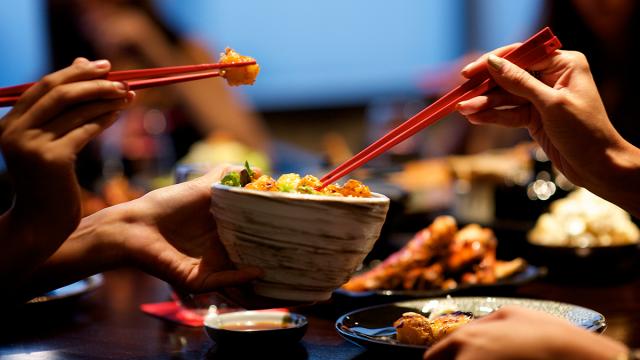Chinese people have used chopsticks for at least 3,000 years. Thanks to the capability of chopsticks themselves, they have been the main tableware for a quarter of the population in the world for thousands of years.
This article is for advanced Chinese readers. There is a good mix of vocabularies related to physical movement, biology, and entertainment inside the article.
[otw_shortcode_tabslayout tabs=”2″ tab_1_title=”Simplified Chinese” tab_1_content=”中国人使用筷子的历史至少有三千多年了。由于筷子本身的功能,两根棍子似的筷子,千百年来一直作为世界四分之一人民的主要餐具。
筷子具有的夹,拨,拣等功能,完全适应人们进餐的需要。譬如用筷子吃面条,只需一只手就可轻易地把面条截短,夹起,送入口中;而刀,叉,却很难独立完成这些动作。著名的美籍华人物理学家李政道博士在日本拜访东京时,就曾高度评价了中国这一古代科技成就。他说,如此简单的两根棍子,却应用了物理学上的杠杆原理。筷子是人类手指的延长,手指能做的事,它几乎都能做,且不怕热,不怕冷,真是了不起的创新。
其实,中国人也曾刀与筷子并用进餐。那么后来为什么放弃使用刀而专门用筷子呢?据说,一是因为刀是武器,在宴会上出现会影响欢乐气氛;二是烹饪技术大大发展,肉不必在桌子上现吃现切了,刀自然也不必拿出来了。
在实际生活中,筷子在中国不仅仅是一种餐具,它还有着多种功能,像是被运用于音乐,舞蹈。「筷子击琴」,古代就有传说,而「筷子舞」则是中国少数民族的优美舞蹈。
至于使用筷子有益健康,也是有科学佐证的。根据日本学者的研究:「当人们使用筷子的时候,同时牵动手指,胳臂,肩膀等三十多个关节和五十多条肌肉,而这些关节和肌肉又与大脑相联系。因此,使用筷子对调节神经,刺激头脑也是非常有益的,还能使人心灵手巧。
正是由于筷子具有多种功能,现在,不仅华人保持着以筷子进餐的传统,不少外国人也开始学习如何使用筷子。即使有些外国人虽不习惯用筷子,但却把它作为工艺品而加以收集或赠送给朋友。
” tab_2_title=”Traditional Chinese” tab_2_content=”
中國人使用筷子的歷史至少有三千多年了。由於筷子本身的功能,兩根棍子似的筷子,千百年來一直作爲世界四分之一人民的主要餐具。
筷子具有的夾,撥,揀等功能,完全適應人們進餐的需要。譬如用筷子吃麵條,只需一隻手就可輕易地把麵條截短,夾起,送入口中;而刀,叉,卻很難獨立完成這些動作。著名的美籍華人物理學家李政道博士在日本拜訪東京時,就曾高度評價了中國這一古代科技成就。他說,如此簡單的兩根棍子,卻應用了物理學上的槓桿原理。筷子是人類手指的延長,手指能做的事,它幾乎都能做,且不怕熱,不怕冷,真是了不起的創新。
其實,中國人也曾刀與筷子並用進餐。那麼後來爲什麼放棄使用刀而專門用筷子呢?據說,一是因爲刀是武器,在宴會上出現會影響歡樂氣氛;二是烹飪技術大大發展,肉不必在桌子上現吃現切了,刀自然也不必拿出來了。
在實際生活中,筷子在中國不僅僅是一種餐具,它還有着多種功能,像是被運用於音樂,舞蹈。「筷子擊琴」,古代就有傳說,而「筷子舞」則是中國少數民族的優美舞蹈。
至於使用筷子有益健康,也是有科學佐證的。根據日本學者的研究:「當人們使用筷子的時候,同時牽動手指,胳臂,肩膀等三十多個關節和五十多條肌肉,而這些關節和肌肉又與大腦相聯繫。因此,使用筷子對調節神經,刺激頭腦也是非常有益的,還能使人心靈手巧。
正是由於筷子具有多種功能,現在,不僅華人保持着以筷子進餐的傳統,不少外國人也開始學習如何使用筷子。即使有些外國人雖不習慣用筷子,但卻把它作爲工藝品而加以收集或贈送給朋友。
“][/otw_shortcode_tabslayout]
English translation:
Chinese people have used chopsticks for at least 3,000 years. Thanks to the function of chopsticks themselves, two stick-like chopsticks have been the main tableware for a quarter of the population in the world for thousands of years.
They have the functions of clamping, pushing away, and picking up, which fully meet the needs of people to eat. For example, when eating noodles with chopsticks you can easily cut, clamp and put the noodles into the mouth by only one hand; while knives and forks are difficult to complete these actions independently. A famous Chinese American physicist Dr. Zheng-dao Li highly admired this Chinese ancient technological achievements when he visited Tokyo, Japan. He said that such two simple sticks apply the principle of a lever in physics. Chopsticks are the extension of human fingers. What the fingers can do, they can almost achieve as well, and they are neither afraid of the heat, nor the cold. They are really a remarkable innovation.
In fact, the Chinese used to eat with knives and chopsticks together. Then why did the Chinese give up using knives and choose to use chopsticks? For one thing, it is allegedly because knives are a kind of weapon, and the appearance of them will affect the atmosphere of joy in the banquet; for another, the cooking technology had been greatly developed. The meat didn’t have to be dealt with on the table on the scene so that knives reasonably didn’t have to be taken out.
In real life, chopsticks are more than just a kind of tableware in China. It has many functions such as being used in music and dance performance. “Chopsticks hit the piano” is a legend in ancient times, and “Chopsticks Dance” is a beautiful dance in one of the Chinese ethnic minorities.
As for the benefits of using chopsticks for health, that is also supported by science. According to Japanese scholars’ research, when people use chopsticks, they also contract more than 30 joints and 50 odd muscles, such as fingers, arms, and shoulders. These joints and muscles are connected to the brain. Therefore, using chopsticks is also very beneficial for adapting the nerves and stimulating the brain.
Exactly because of the multiple functions of chopsticks, now, there are not only Chinese people who still maintain the tradition of eating with chopsticks, but many foreigners also learn how to use them. Although some foreigners are not used to using chopsticks, they collect them as a craft or give them to friends.
The article is rewritten from a printed article. The photo is taken from here.

